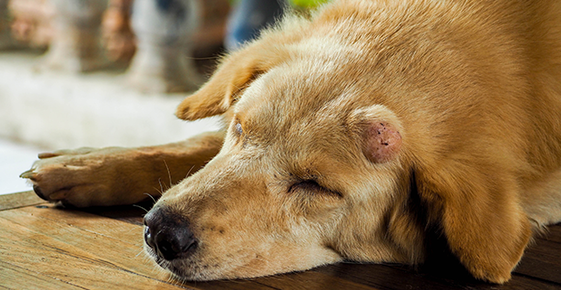
Tumors, masses, lumps, and bumps are seen in the clinic on a daily basis. Owners usually find lumps and bumps on their animals when they are petting them. Some masses are benign, but others may be malignant and will require further investigation. These masses may vary in size, shape, color, and the way they feel. If you find a mass on your pet the best thing to do is to call your veterinarian and have it checked out.
What is a Tumor?
A tumor is an abnormal growth of cells. The cells may be dividing more than they should or they do not die when they should causing the tumor to form and grow. These masses may be non cancerous (benign) or they may be cancerous (malignant). Benign growths can change in size and become large, but they do not spread to other tissues or parts of the body. Malignant tumors on the other hand do have potential to spread and invade other tissues and body parts.
Prior to Surgery
A physical exam is required prior to all surgical procedures. At this time the growth is measured and notes are taken on size, shape, color, location, and the way it feels. A sample is taken with a needle and syringe and is placed on a microscope slide. The slide is then stained with special dyes and viewed under the microscope. This procedure is called a fine needle aspirate. Depending on what is found on the slide, in some cases we can wait and monitor the growth, and in other cases surgical removal is needed.
There are many reasons as to why a tumor would need to be removed. A tumor would need to be removed if it is malignant, meaning cancerous. Some tumors may be benign, but if the pet is bothered by them or if they hinder mobility, like masses in the groin or armpit area, then surgical removal is recommended. It is better and easier to remove a tumor when it is smaller than when it has grown to a much larger size.
If we proceed with surgery, then pre anesthetic bloodwork is required. This bloodwork looks into white blood cells, red blood cells, liver values, kidney values, and clotting times to ensure the patient can tolerate anesthesia and the surgery well.
Types of Masses Commonly Removed
Sebaceous adenomas
Sebaceous adenomas, otherwise known as “old dog warts,” are very commonly seen as dogs get older. These are a benign tumor of the oil gland located on the skin. Treatment is not required for these types of growths. Surgical removal is only recommended if they break open, bleed, become infected or are excessively large. They may also be removed if they become irritated by collars, harnesses, or during grooming. A common location for sebaceous adenomas is on the eyelid, which potentially may irritate the eye and cause corneal ulcers and will require surgical removal.
Acrochordon/Fibroepithelial polyp
Acrochordon and fibroepithelial polyp are better known as skin tags. Skin tags are a benign overgrowth of the connective tissue of the skin. They can vary in size from as small as a grain of rice to long and dangly growths. They usually grow in areas of increased pressure or from repeated friction. Just like with sebaceous adenomas, surgical removal is only necessary if they become irritated or impede their daily routine.
Lipomas
Lipomas, or “fatty tumors” are one of the most common tumors that are seen in the clinic. They are a benign tumor made up of fat. These tumors can grow anywhere on the body, but are most commonly seen under the skin where fat is normally present. Removal of these masses is usually recommended once they begin to grow or if they begin to hinder movement.
Histiocytomas
Another commonly seen tumor is a histiocytoma. They are a benign tumor made up of histiocytes. In the first few weeks these usually grow rapidly and may become ulcerated. They are usually seen in younger dogs and tend to resolve on their own within a few months. Removal is needed when they begin to bleed, become ulcerated or infected. Histiocytomas are diagnosed by getting a sample with a needle from the mass and looking at it under a microscope or sending the sample out to the lab.
Mast Cell Tumors
A mast cell tumor is the most common malignant (cancerous) skin tumor seen in dogs. It is a cancer of a certain type of white blood cell (mast cell). This cell releases histamine and causes an allergic response and causes inflammation. Mast cell tumors vary in appearance greatly. Some tumors may be present for months without changing, while others can appear out of nowhere and may grow very quickly. They may present as a raised lump on or under the skin that changes in size. They may also be red, ulcerated, or swollen.
Mast cell tumors are typically diagnosed via fine needle aspirate and examination of cells under the microscope. These types of tumors have the potential of spreading to lymph nodes, liver, spleen, and other areas of the body, so surgical removal is imperative. Histopathology is needed to determine what grade the tumor is and to determine what to expect in the future for reference or spread to other location.
For more information, visit the following links:
https://www.aaha.org/your-pet/pet-owner-education/ask-aaha/canine-cancer/
https://www.aaha.org/aaha-guidelines/oncology-configuration/diagnosis-of-tumor-type/
https://www.aaha.org/your-pet/pet-owner-education/ask-aaha/canine-cancer/


